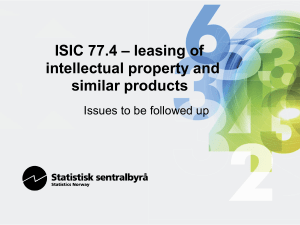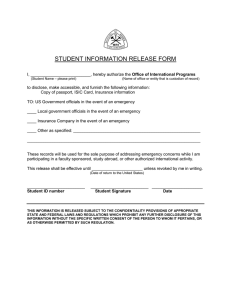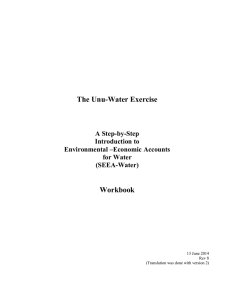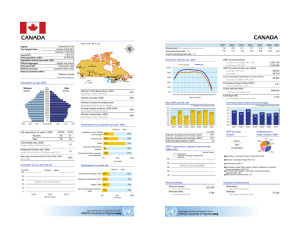Physical Supply and Use Tables in SEEAW: Technical Workshop on the
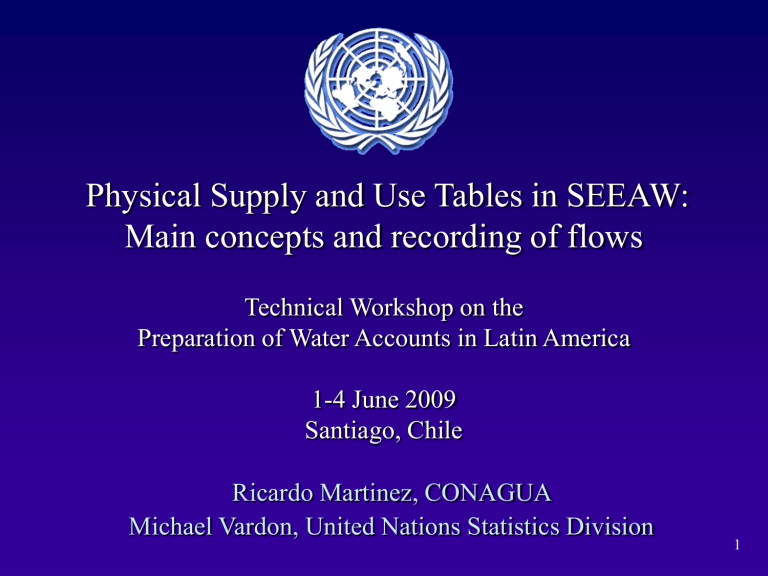
Physical Supply and Use Tables in SEEAW:
Main concepts and recording of flows
Technical Workshop on the
Preparation of Water Accounts in Latin America
1-4 June 2009
Santiago, Chile
Ricardo Martinez, CONAGUA
Michael Vardon, United Nations Statistics Division
1
Outline
•
What do Physical Supply-Use Tables
(PSUT) measure?
•
Concepts
•
The standard tables of SEEA Water
•
Supplementary tables
•
Some data recording issues
What do PSUT measure?
PSUT describe in physical units
•
The exchanges of water between the environment and the economy
(abstraction and returns)
• The exchanges of water within the economy
(supply and use within the economy)
Why compiling physical supply and use tables?
They are important because
•
They allow for the identification of the industries/sectors which put pressure on the environment via extraction and use
•
They indicate the industries/sectors consuming the most water
•
Together with monetary data (e.g. from the hybrid accounts), they provide information on water use efficiency and other information useful for water allocation policies
Atmosphere
Inland Water Resource System
SEEA Water
Overview
•
Stocks and flows
•
Economy and environment upstream basins and aquifers outside the territory of reference
Inflows
Surface water
(reservoirs, lakes, rivers, snow, ice and glaciers)
Natural transfers
(e.g. infiltration, seepage, etc.)
Groundwater
Sea
Collection of precipitation
Abstraction
Soil water
Outflows downstream basins and aquifers outside the territory of reference
Evapotranspiration
Sea
Sewerage
Households
This is a complex system, so it is useful to simplify it
Rest of the World
Economy
Imports
Water collection, treatment and supply
Economy
Other Industries
(incl. Agriculture)
Exports
Rest of the World
Economy
Basic concepts and definitions
From the environment
(abstraction)
Consumption
Use
Evapotranspiration
Supply
To the environment
(returns)
Economic activity/
Households
From another economic unit
Consumption
To another economic unit
Water Use
Water use: water intake of industries and households for production and consumption activities. Water Use is the sum of water use within the economy and water use from the environment .
Water use within the economy : water intake for production and consumption activities, which is distributed by industries or households and by the Rest of the World (Imports).
Water use from the environment : water abstracted from water resources, seas and oceans, and precipitation collected by industries and households for production and consumption activities, including rainfed agriculture.
Water Supply
Water supply: water leaving/flowing-out from an economic unit
(Industries, Households and rest of the world). Water supply is the sum of water supply to other economic units and water supply to the environment .
Water supply to the environment (also Water returns): water returned into the environment during a given period of time after use. Returns can be classified according to the receiving media
(i.e. water resources and sea water) and to the type of water (e.g. treated water, cooling water, etc.).
Water supply within the economy: water distributed to households and industries (including agriculture) and to the rest of the world
(exports). Water supply within the economy is net of losses in distribution.
Organisation of the Physical
Supply-Use Tables
•
By columns, industries (ISIC Rev.4), households and the Rest of the world
•
By rows, types of flows
Within the economy the SNA identity “Supply is equal to the Use” holds
They consist of three parts:
• Abstraction (in-flow) of water from the environment to the economy
•
Flows within the economy
•
Returns (or out-flows) of water from the economy to the environment
Flows from the environment to the economy
M illio ns m 3
Industries (by ISIC catego ries)
1-3
5-33,
41-43 35 36 37
38,39,
45-99 To tal
Fro m the enviro nment
1. T o t a l a bs t ra c t io n (=1.a+1.b=1.i+1.ii)
1.a. A bstractio n fo r o wn use
1.b. A bstractio n fo r distributio n
1.i. Fro m water reso urces:
1.i.1 Surface water
1.i.2 Gro undwater
1.i.3 So il water
1.ii. Fro m o ther so urces
1.ii.1 Co llectio n o f precipitatio n
1.ii.2 A bstractio n fro m the sea
Flows within the economy
2. Use of water received from other economic units
4. Supply of water to other economic units of which:
4.a. Reused water
4.b. Wastewater to sewerage
1-3
Industries (by ISIC categories)
5-33,
41-43 35 36 37
38,39,
45-99 Total
Millions m3
Flows from the economy to the environment
M illio ns m 3
To the enviro nment
5 . T o t a l re t urns (=5.a+5.b)
5.a. To water reso urces
5.a.1. Surface water
5.a.2. Gro undwater
5.a.3. So il water
5.b. To o ther so urces (e.g. sea water)
Industries (by ISIC catego ries)
1-3
5-33,
41-43 35 36 37
38,39,
45-99 To tal
Standard PSUT
Water consumption
Water consumption : part of water use which is not distributed to other economic units and does not return to the environment (to water resources, sea and ocean) because during use it has been incorporated into products, consumed by households or livestock.
It is calculated as a difference between total use and total supply, thus it may include losses due to evaporation occurring in distribution and apparent losses due to illegal tapping and malfunctioning metering
Supplementary tables and information
•
The standard tables are the minimum required to meet agreed international standards
•
Countries can disaggregate the industries and line items to suite individual needs
•
In many case it is useful to have these data separately identified in the data collection, estimation and compilation processes
•
If the data are available and of sufficient quality then making it available will enhance it usefulness to decision makers and others
Supplementary information:
Abstraction for own use
Line item 1.a. abstraction for own use:
•
Hydroelectric power generation
•
Irrigation water
•
Mine water
•
Urban runoff
•
Cooling water
•
Other
Supplementary information:
Use of water received from other economic units
Line item 2. Use of water received from other economic units. This can be disaggregated to show:
•
Water abstracted from the environment for distribution
(Distributed water)
• Reused water
• Wastewater to sewerage
•
Note that reuse water and wastewater are shown in the standard supply table in line items 4.a and 4.b, respectively.
Supplementary information:
Supply of water to other economic units
Line item 4. Supply of water to other economic units. This can be disaggregated to show:
•
Water abstracted from the environment for distribution
(Distributed water)
•
Reused water (already shown, item 4.a)
•
Wastewater to sewerage (already shown, item 4.b)
• Desalinated water
• Note: Desalinated is included in the use table (line item
1.ii.2) as an abstraction from the environment.
Additional information: further disaggregation industries
ISIC Rev.4, 1-3
• Agriculture (ISIC Rev.4, 1)
• Forestry (ISIC Rev.4, 2)
•
Fishing (ISIC Rev.4, 3)
ISIC Rev.4, 5-33 and 41-43
•
Mining (ISIC Rev.4, 5-9)
•
Manufacturing (ISIC Rev.4,
10-32)
ISIC Rev.4, 38,39 and 45-
99
• Accommodation (ISIC
Rev.4, 55)
• Food service (ISIC
Rev.4, 56)
• Public Administration
(ISIC Rev.4, 84)
• Etc…
Matrix of transfers within economy
•
This table is symmetrical.
•
Is done to match line items 2 and 4 of the supply and use tables
•
Can be done for each of the components of line items 2 and 4 (i.e. distributed water, reuse water and wastewater to sewerage)
•
It construction allows you to check that supply = use within the economy.
Supplementary information:
Matrix of flows within the economy
Industries (by ISIC categories) to: from: 1-3
5-33,
41-43 35 36 37
38,39,
45-99 Total
1
2-33, 41-43
35
36
37
38,39, 45-99
Total
Households
Rest of the w orld
Total use
Some data recording issues
•
Water supply and sewerage services are provided by the same enterprise
•
Losses in distribution
• Water supply industry (ISIC Rev.4, 36): intraindustry transfers
•
Hydro-electric power (classification enterprises and recording)
• Mine ‘de-watering’
•
Urban run-off
•
Cooling water
Enterprises supplying both water and sewerage services
• In many countries it is common for one enterprise to provide both natural water (CPC v.2, 1800) and sewerage services (CPC v.2, 941)
• In national accounts they will coded according to which product generates the highest value output.
•
If it is natural water (CPC v.2, 1800) then it will be
Water Supply (ISIC Rev.4, 36).
• If it is sewerage services (CPC v.2, 941) then it will be
Sewerage (ISIC Rev.4, 37)
•
In practice many countries do not separate these industries in the national accounts
Enterprises supplying both water and sewerage services
• In SEEAW these enterprises should be split into two establishments
•
One supplying natural water (CPC v.2, 1800) and coded to Water Supply (ISIC Rev.4, 36).
• The other supplying sewerage services (CPC v.2, 941) and coded to Sewerage (ISIC Rev.4, 37)
• If they are not split then the flows to and from these industries and to other industries becomes less clear
•
If they cannot be split then the line items 2 (Use of water from other economic units) and 4 (supply of water to other economic units) should be subdivided to show wastewater to sewerage, reuse water and distributed water (as shown earlier in the presentation)
Losses in distribution
•
This is an important policy area and because they are not shown explicitly in the standard supply and use table countries should consider preparing the SEEAW supplementary table on losses in distribution
Losses in distribution: treatment in standard tables
•
Water losses in distribution is the volume of water lost during transport through leakages, theft and evaporation between a point of abstraction and a point of use, and between points of use and reuse.
•
Water supply within the economy is recorded net of water losses in distribution
•
Losses are recorded in water abstractions from the environment, leakages are recorded in water returns and may be separately recorded under water consumption
• The are not explicitly identified
Supplementary information:
Losses in distribution
1. (Net) Supply of w ater to other economic units
2. Losses in distribution (=2.a+2.b)
2.a Leakages
2.b Other (e.g. evaporation, apparent losses)
3. Gross supply w ithin the econom y (=1.+2.)
Industries (by ISIC categories)
1-
3
5-33,
41-43 35 36 37
38,39,
45-99 Total
Millions m3
Water Supply Industry (ISIC Rev.4, 36)
– Intra-industry transfers
•
In some countries different enterprises within the water industry transfers water between themselves
•
It is important to understand these transfers:
•
To avoid double counting
•
For policy analysis and decision makers, especially where the price of water varies
(for example between regions and between water “wholesalers” and water
“retailer”)
Intra industry supply
Water Supply Industry ISIC Rev.4, 36
Enterprise A
ISIC 36
120
50
180
Enterprise C
ISIC 36
50
Enterprise B
ISIC 36
40
140
Enterprise D
ISIC 36
Enterprise E
ISIC 36
40
140
Water users
Water Supply Industry (ISIC Rev.4,
36) – Intra-industry transfers
•
The standard physical supply and use tables do not record these within industry transfers
•
In countries where this occurs a table showing these should be developed to assist the compilation process and could also be presented as supplementary information
•
SEEAW does not have a standard table for intra-industry transfer this but one has been developed by UNSD
Water Supply Industry (ISIC Rev.4,
36) – intra-industry transfers
Supplied to
A
B
C
D
E
All other ISICs
Gross supply of ISIC 36
Net supply of ISIC 36
Supply from
A
180
50
120
350
120
B
Enterprises in ISIC 36
40
140
0
180
0
C
50
50
50
D
40
40
40
E
140
140
140
ISIC 36
Total
350
760
350
Hydro-electric power
•
Hydro-electric power can be a very large water user in countries. While the water is used it is not consumed
•
Even though the water is not consumed it is important to record these flows because:
•
The water is an essential input to the output of hydro-electricity (and hence an important consideration in decision making and policy analysis)
• This use may take place at the expense of other uses
•
The water made available by the infrastructure that supports hydro-electric power and the water available after use are important water sources for industry
Hydro-electric power: classification of enterprises
Is it the Electricity Supply or Water Supply Industry?
• The enterprise engaged in the production of hydroelectricity produce two products or outputs
•
Electricity (CPC v.2, 171)
•
Natural water (CPC v.2, 1800)
•
In most case the value of the output of energy exceeds the value of the output of water.
•
As such hydro-electric enterprises are mostly classified to the Electricity Supply Industry (ISIC Rev. 4, 35) in the national accounts of countries
•
This creates a problem for recording flows in the physical supply and use tables (and hybrid tables)
The solution to the hydro-electric classification problem
• Split the hydro-electricity enterprise into two establishments
•
One produces Electricity (CPC v.2, 171) and is classified to Electricity Supply (ISIC Rev. 4, 35)
•
The other producers Natural water (CPC v.2, 1800) and is classified to Water Supply (ISIC Rev. 4, 36)
•
For the establishment classified to ISIC 35 water is recorded as an abstraction for own use, with the volume of water returned equal to the amount abstracted. This results in zero (0) consumption
•
For the establishment classified to ISIC Rev.4, 36 the water is recorded as an abstraction for distribution
Recording of water use for Electricity Supply (ISIC Rev.4, 35)
S EEAW S tandard Table I: Physical use table
Indus trie s (by IS IC c a te go rie s )
1
2-33,
41-43
35
From the environme nt
1 - Total abstraction (=1.a+1.b = 1.i+1.ii)
1.a Abstraction for own use
1.b Abstraction for distribution
1.i From water resources:
1.i.1 Surface water
1.i.2 Groundwater
1.i.3 Soil water
1.ii From other sources
1.ii.1 Collection of precipitation
1.ii.2 Abstraction from the sea
Within the economy 2. Use of water received from other economic units
3. Total use of water (=1+2)
Note: grey cells indicate zero entries by definition.
S EEAW S tandard Table II: Physical supply table
Indus trie s (by IS IC c a te go rie s )
1
2-33,
41-43
35
Within the
4. Supply of water to other economic units of which : economy
To the
4.a Reused water
4.b Wastewater to sewerage
5. Total returns (= 5.a+5.b)
5.a To water resources environme nt
5.a.1 Surface water
5.a.2 Groundwater
5.a.3 Soil water
5.b To other sources (e.g. sea water)
6. Total supply of water (= 4+5)
7. Consumption (3-6)
Note: grey cells indicate zero entries by definition.
is recorded as an abstraction for own use of surface in the
Amount of water returned is recorded is the supply table, as return to surface water
P hys ic a l units use table
If the amount returned is equal to the amount abstracted then the consumption is zero. If pollution has been added then this would be recorded in the emission account
Alternative solution to the hydroelectric classification problem
If it is impossible to split the hydro-electricity enterprise into two establishments then:
•
In the use table the water should be recorded in line item 1 as an abstraction form the environment, however you will not be able to fill in either line item
1.a or 1.b as it is both an abstraction for distribution and an abstraction for own use
•
In the supply table it will be recorded in line item as a supply to other economic units
•
It IS NOT recorded in line item 5 as a Total return as it is the first treatment.
Alternative recording of water use and supply by Electricity Supply (ISIC Rev.4, 35)
S EEAW S tandard Table I: Physical use table
Indus trie s (by IS IC c a te go rie s )
Amount of water abstracted
P hys ic a l units is recorded in use table in
1
2-33,
41-43
35
Total abstraction (item 1) but not in items 1.a or 1.b
From the environme nt
1 - Total abstraction (=1.a+1.b = 1.i+1.ii)
1.a Abstraction for own use
1.b Abstraction for distribution
1.i From water resources:
1.i.1 Surface water
1.i.2 Groundwater
1.i.3 Soil water
1.ii From other sources
1.ii.1 Collection of precipitation
1.ii.2 Abstraction from the sea
Within the economy 2. Use of water received from other economic units
3. Total use of water (=1+2)
Note: grey cells indicate zero entries by definition.
Amount of water supplied to other economic units is recorded is the supply table.
S EEAW S tandard Table II: Physical supply table
Indus trie s (by IS IC c a te go rie s )
1
2-33,
41-43
35
P hys ic a l units
No return to the environment is recorded.
Within the
4. Supply of water to other economic units of which : economy
To the
4.a Reused water
4.b Wastewater to sewerage
5. Total returns (= 5.a+5.b)
5.a To water resources environme nt
5.a.1 Surface water
5.a.2 Groundwater
5.a.3 Soil water
5.b To other sources (e.g. sea water)
6. Total supply of water (= 4+5)
7. Consumption (3-6)
Note: grey cells indicate zero entries by definition.
If the amount supplied is equal to the amount abstracted then the consumption is zero.
Mine de-watering
• In underground mining water is often pumped out of the mine
•
It is important to record these flows as
•
This may prevent others from using the groundwater
• The groundwater is usually discharge into surface water and may be of a different quality due to natural processes or because of pollutants added
•
In arid areas this may disrupt the ecology of the environment
• Once on the surface it can be used by others
Recording mine de-watering
S EEAW S tandard Table I: Physical use table
Indus trie s (by IS IC c a te go rie s )
1
2 - 3 3 ,
4 1- 4 3 35
Amount of water abstracted is recorded as an abstraction
P hys ic a l units for own use of groundwater in the use table
From the environme nt
1 - Total abstraction (=1.a+1.b = 1.i+1.ii)
1.a Abstraction for own use
1.b Abstraction for distribution
1.i From water resources:
1.i.1 Surface water
1.i.2 Groundwater
1.i.3 Soil water
1.ii From other sources
1.ii.1 Collection of precipitation
1.ii.2 Abstraction from the sea
Within the economy 2. Use of water received from other economic units
3. Total use of water (=1+2)
Note: grey cells indicate zero entries by definition.
Amount of water returned is recorded is the supply table, as return to surface water
S EEAW S tandard Table II: Physical supply table
Within the
4. Supply of water to other economic units of which : economy
To the
4.a Reused water
4.b Wastewater to sewerage
5. Total returns (= 5.a+5.b)
5.a To water resources environme nt
5.a.1 Surface water
5.a.2 Groundwater
5.a.3 Soil water
5.b To other sources (e.g. sea water)
6. Total supply of water (= 4+5)
7. Consumption (3-6)
Note: grey cells indicate zero entries by definition.
1
2 - 3 3 ,
4 1- 4 3
Indus trie s (by IS IC c a te go rie s )
35 equal to the amount abstracted then the consumption is zero. If pollution has been added then this would be recorded in the emission account
Urban run-off
•
Urban run-off (or storm water) is the precipitation that falls on urban areas that does not evaporate or percolate into the ground but flows via overland flow, underflow or channels or is piped into a water cannel or constructed infiltration facility.
• When urban run-off is collected by the sewerage or storm water system the supply and use of this water is recorded against the Sewerage Industry
(ISIC Rev. 4, 37)
Recording of urban run-off
S EEAW S tandard Table I: Physical use table
35 36
37
From the environme nt
1 - Total abstraction (=1.a+1.b = 1.i+1.ii)
1.a Abstraction for own use
1.b Abstraction for distribution
1.i From water resources:
1.i.1 Surface water
1.i.2 Groundwater
1.i.3 Soil water
1.ii From other sources
1.ii.1 Collection of precipitation
1.ii.2 Abstraction from the sea
Within the economy 2. Use of water received from other economic units
3. Total use of water (=1+2)
Note: grey cells indicate zero entries by definition.
S EEAW S tandard Table II: Physical supply table
35 36
37
Within the
4. Supply of water to other economic units of which : economy 4.a Reused water
4.b Wastewater to sewerage
5. Total returns (= 5.a+5.b)
5.a To water resources
To the environme nt
5.a.1 Surface water
5.a.2 Groundwater
5.a.3 Soil water
5.b To other sources (e.g. sea water)
6. Total supply of water (= 4+5)
7. Consumption (3-6)
Note: grey cells indicate zero entries by definition.
Amount of water abstracted is recorded as an abstraction
P hys ic a l units from other sources in the use table
Amount of water returned is recorded is the supply table, as return to surface water or to sea equal to the amount abstracted then the consumption is zero. If pollution has been added then this would be recorded in the emission account
Cooling water
• Cooling water is defined as water which is used to absorb and remove heat
•
When discharge is may cause thermal pollution or have collected pollutants during use (e.g. if used in metal manufacture)
•
In some cases industries using water for cooling recycle it
“on site”. In other cases it is abstracted and returned to the environment
• You need to carefully distinguish which situation is occurring, particularly for large users of cooling water (for example coal fired electricity generators)
Cooling water
Case one: Recycling
Boundary of establishment
Water abstract from environment only to replace the water consumed by the industry
Establishment using water for cooling
100
Environment
80
80
Cooling pond of establishment
Water discharged to pond and then extracted from pond.
Establishment may report an
“intake” of 180 rather than an abstraction from environment for own use of 100. This would be a consumption of 100.Must be
Very careful when interpreting data from surveys or other sources
Cooling water
Case two: Abstraction and return
Establishment
Using water for cooling
Environment
Water abstracted from environment and returned to the environment.
Difference is the consumption.
100 abstracted for own use – 80 returned =
20 consumption
Cooling water – be careful!
•
If you misinterpret the situation you may over or under estimate to volume of water consumed
•
Contact directly the large water users (e.g. coal fired electricity generators to be sure what the situation is
Conclusion
•
SEEAW uses existing international classifications
(CPC and ISIC) a catagorisation of water flows to describing the flows of water within the environment, and economy as well as between the environment and economy.
•
Most flows are easily identified and recorded in the standard tables.
•
The catagoristion of the enterprises in the economy is important, particularly for enterprises hydro-electric power plants and water and sewerage service suppliers.
•
UNSD is
Contact details
Michael Vardon
UN Statistics Division
New York 10017 USA
Room DC2 1532
Ricardo Martinez
CONAGUA
Av. Insurgentes Sur 2416
México, D.F. 04380
Phone: +1 917 367 5391
Fax: +1 917 963 1374
Email: vardon@un.org
Phone: +52-55-5174-4480
Fax: +52-55
Email: ricardo.martinez@conagua.gob.mx
